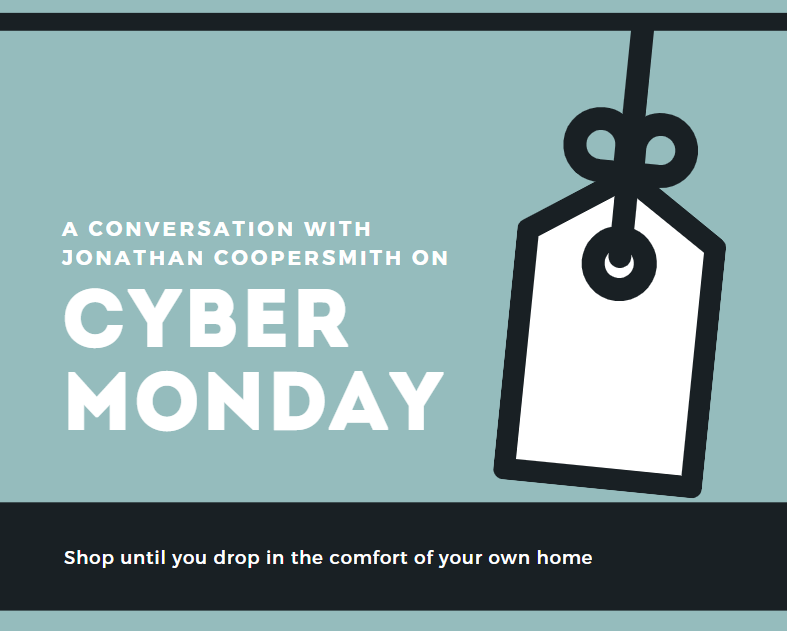Shop until you drop in the comfort of your own home
Today is Cyber Monday, the Monday following Thanksgiving, promoted by online retailers as a day for exceptional bargains. The College of Liberal Arts sat down with a history professor to discuss how technology shapes our views on shopping.

It’s the end of Thanksgiving, which for many people means deals upon deals (online or in-store). We sat down with Jonathan Coopersmith of the Department of History, who researches the importance of froth (speculative, likely-to-fail), fraud, and fear in emerging technologies, to gain an understanding of the history of how technology affects us as consumers. This interview has been condensed for length and clarity.
What is your area of research?
I am a historian of technology currently researching the importance of froth, fraud, and fear in emerging technologies.
How has technology shaped and changed shopping and consumerism?
Technologies historically are an essential factor shaping shopping and consumerism. One visible trend has been increasingly fast online ordering and delivery, which are expansions of ordering from catalogs and delivery by mail or parcel service.
Less visible are the supply and credit chain technologies that allow stocking of goods in stores as well as online selling. Just think of the challenges of keeping thousands of items in stock and, in the case of groceries, fresh. It’s amazing what we take for granted.
“Less visible are the supply and credit chain technologies that allow stocking of goods in stores as well as online selling… It’s amazing what we take for granted.”
What about in regards to Black Friday or Cyber Monday?
That’s a triumph of advertising, of convincing people of the potential savings (which may not always be real) and the excitement of shopping en masse after Thanksgiving.
How do economists and historians perceive Black Friday and Cyber Monday?
I cannot speak for my colleagues, but I’m impressed by how evolving and flexible these events are. Giving Tuesday was developed as a response to all of the buying by encouraging people to think of charitable and non-profit causes with their consuming.
Economically, these days are like football weekends at Texas A&M – businesses depend on them for a disproportionate share of their annual profits.
How did the trends of online shopping arise?
The concept of distant shopping in the United States really began when Congress, responding to public pressure from farm groups, created Rural Free Delivery (RFD) by the Post Office in 1896. Farmers could petition to have the Post Office establish delivery routes to farms. Local stores, fearing competition, had opposed RFD. This enabled mail-order stores like Montgomery Ward and Sears, Roebuck and Company to send millions of catalogs across the US and then mail the received orders directly to recipients’ homes. Sears started selling watches in 1888 by catalog and launched its first general catalog in 1894, and really expanded after 1896. It did not open its first store until 1925 to take advantage of the growing spread of the automobile.
How does Cyber Monday engage the trend for online shopping? What do people prefer online shopping?
It’s the lure of the bargain, whether real or imagined, and FOMO – the fear of missing out. In many ways it is more convenient: You can do it anytime and, with a laptop or cellphone or watch, from anywhere. You can avoid traffic and crowds. You can schedule repeat orders. For example, I used to go to Petco to buy cat food. Now Petco automatically sends a monthly order to my house. It still makes money and I pay sales tax, but Petco’s local store loses that sale.
You can shop from any business with a web presence instead of being limited to what is available in person. This is very important for people in rural areas. Also, you get the pleasure of buying something twice – once when you order it and again when it arrives – instead of combining the purchase and the possession at the same time.
What you do not have is the communal or public shopping experience. And local businesses (which may be national or international chains) lose that sale as do related businesses like restaurants. Online shopping is one reason why some malls are falling, some retail stores and chains are shutting, and retail employment has decreased recently. Other causes include automation (e.g., self-checkout), and normal overexpansion, undercapitalization, and bad decisions.
“You get the pleasure of buying something twice – once when you order it and again when it arrives – instead of combining the purchase and the possession at the same time.”
Coopersmith’s study of the history of remote consumerism— from ordering out of a catalog to the current online shopping frenzy — can help you think about your own financial habits. You can keep in mind how the history of the sale affects you as a consumer; or in Coopersmith’s words, the design to get the pleasure of buying something twice and fulfill the lure of the bargain.

